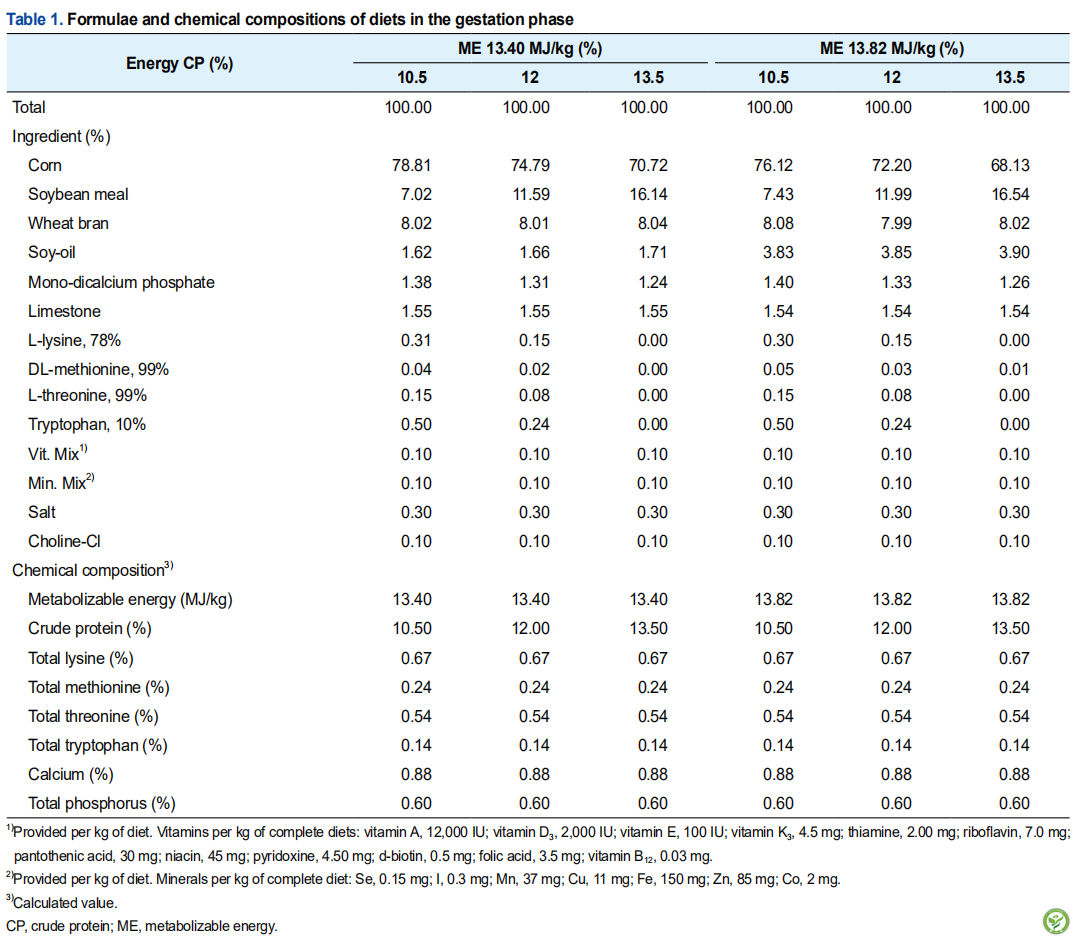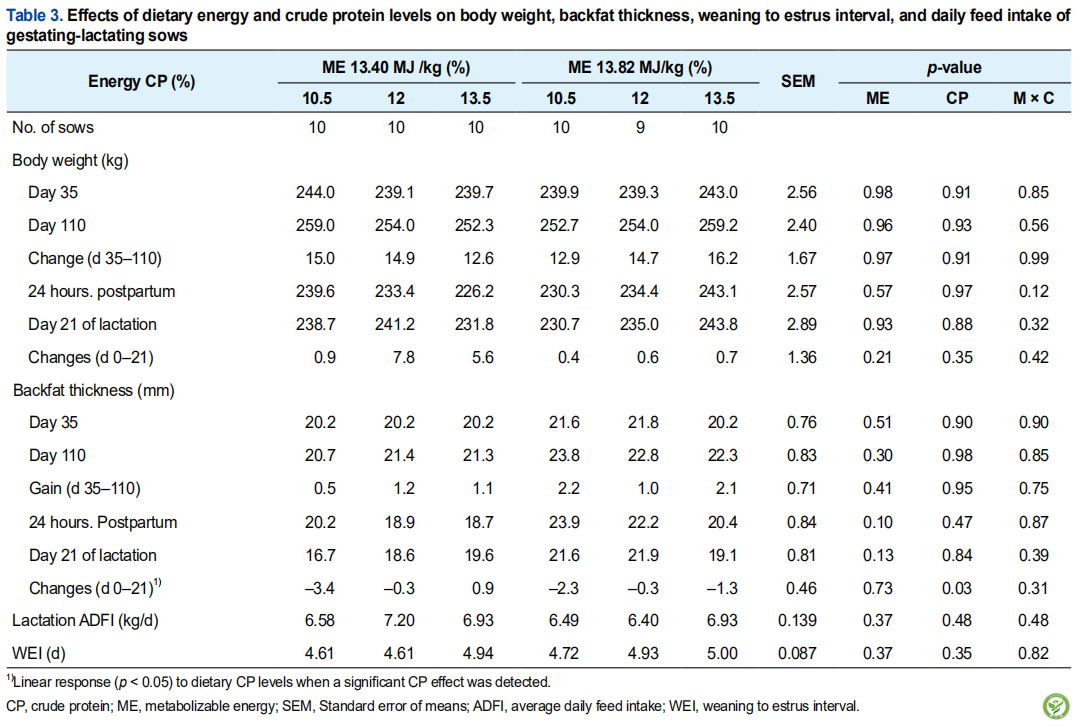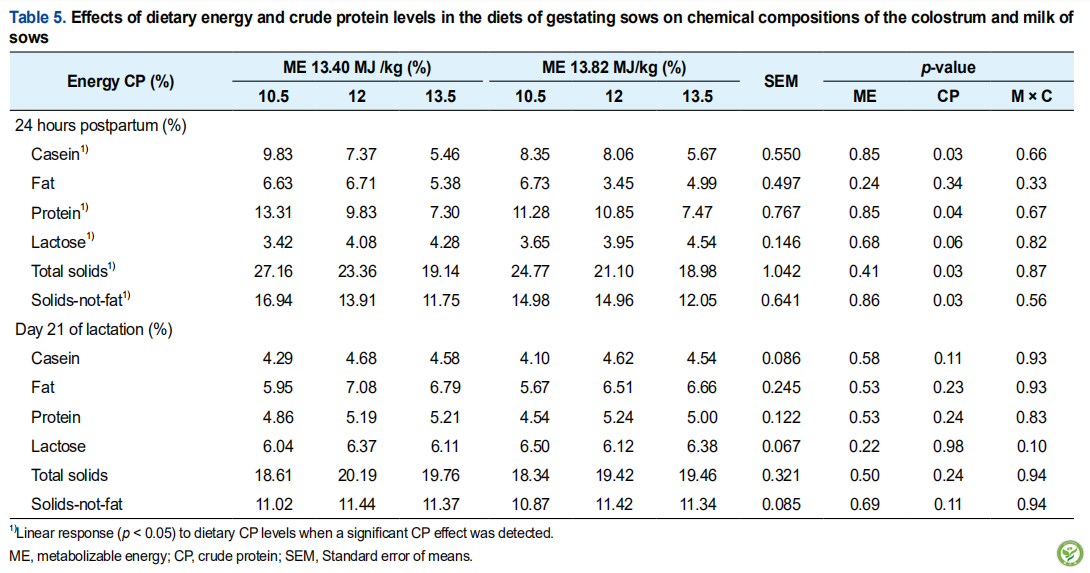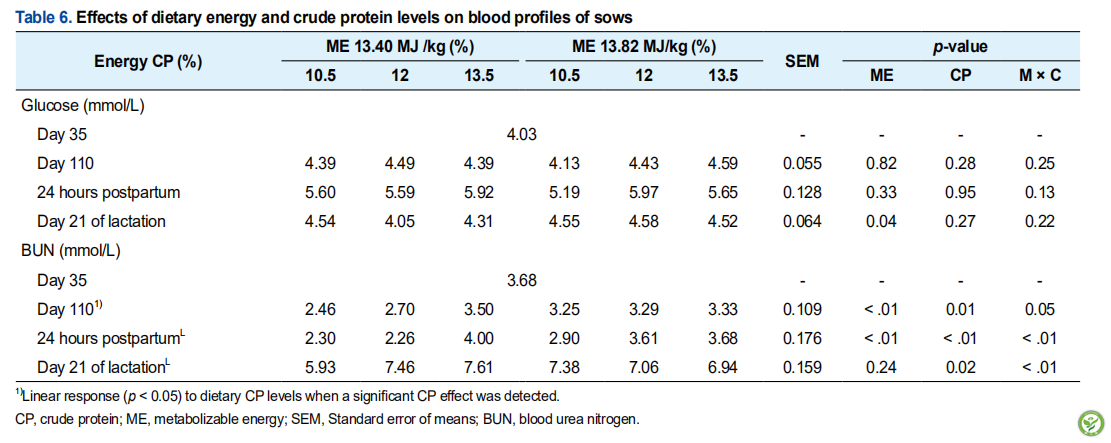Effects of dietary energy and protein levels on reproductive performance in gestating sows and growth of their progeny
作者:Lin Hu Fang1 , Ying Hai Jin2 , Jae Hark Jeong1 , Jin Su Hong1 , Woo Lim Chung1 and Yoo Yong Kim1*
1 School of Agricultural Biotechnology, and Research Institute of Agriculture and Life Sciences, Seoul National University, Seoul 08826, Korea
2 Department of Animal Science, Yanbian University, Jilin Sheng 133000, China
来源:J Anim Sci Technol 2019;61(3):154-162 https://doi.org/10.5187/jast.2019.61.3.154
翻译:肠动力研究院 梁琦
【摘要】本文旨在研究日粮中能量和粗蛋白(CP)水平对妊娠母猪的繁殖性能、猪群生产性能、奶水质量和血液特征的影响。将59头体重(BW,241.67±8.86 kg ),背膘厚(BF)和胎次(3-6胎)相似的多胎母猪(约克夏×大白)随机分配到6个(2×3因子)处理组中,每个处理组9或10头母猪。第一个因素是两个水平的日粮代谢能(ME)浓度(13.40或13.82 MJ / kg),第二个因素是基于妊娠期为35天的三个日粮蛋白水平(10.5%,12%和13.5%)。结果显示,随着日粮中CP水平的增加,哺乳母猪的背膘厚变化呈线性下降(p = 0.03)。提高妊娠母猪日粮中的能量水平往往会增加窝产总仔数(p = 0.07),但仔猪体重却相应下降(p = 0.02)。日粮CP水平对初乳质量有负面影响,究其原因可能是随着妊娠母猪日粮中CP含量的增加,初乳中的酪蛋白,蛋白质,总固形物和非固体脂肪浓度线性下降,乳糖水平则线性增加(酪蛋白%:p = 0.03;蛋白质%:p = 0.04;乳糖%:p = 0.06;总固形物:p = 0.03;非固体脂肪:p = 0.03)。然而,将ME提高0.42 MJ / kg对母猪初乳的化学成分没有显著影响。当母猪在妊娠期间喂食不同能量水平的日粮时,它们的血糖浓度没有显著差异,但当能量增加0.42 MJ / kg时,哺乳期第21天却发现母猪的血糖浓度显著升高(p = 0.04)。当妊娠110天,产后24小时和哺乳期21天时,血尿素氮(BUN)浓度随着日粮蛋白浓度的增加而线性增加(p <0.05,p <0.05,p <0.05);此外还发现,在妊娠100天,产后24小时,血尿素氮浓度也随着日粮中能量水平的增加而线性增加(p < 0.01,p < 0.01)。研究结果表明,当日粮中代谢能和蛋白质水平分别为13.82 MJ / kg 和10.5%时,可提高妊娠母猪的繁殖性能,猪群生产性能和初乳质量。
【关键词】能量,粗蛋白,繁殖性能,猪群生产性能,血液特征,妊娠母猪
以下是相关图表
表1:妊娠期日粮的配方和化学组成

表2:哺乳期日粮的配方和化学组成

表3:日粮中能量和粗蛋白水平对妊娠—泌乳母猪的体重,背膘厚度,断奶至发情间隔和日采食量的影响

表4:日粮能量和粗蛋白水平对妊娠母猪繁殖性能和猪群生产性能的影响

表5:日粮能量和粗蛋白水平对妊娠母猪奶水和初乳的化学成分的影响

表6:日粮能量和粗蛋白水平对母猪血液形态的影响

总结
窝产总仔数随着妊娠母猪日粮中ME的增加(13.40 MJ / kg至13.42 MJ / kg)而增加。而随着日粮CP水平的增加(10.5%-13.5%),母猪的背膘厚度和初乳质量下降,哺乳期间仔猪死亡数和血尿素氮水平增加。研究结果表明,当日粮中代谢能和蛋白质水平分别为13.82 MJ / kg 和10.5%时,可提高妊娠母猪的繁殖性能,猪群生产性能和初乳质量。
Abstract
This experiment was conducted to evaluate the effect of dietary energy and crude protein (CP) levels on reproductive performance, litter performance, milk quality, and blood profiles in gestating sows. A total of 59 multiparous sows (Yorkshire × Landrace) with similar body weights (BW), backfat thickness (BF), and parity were assigned to one of six treatments with 9 or 10 sows per treatment using a 2 × 3 factorial arrangement and completely randomized design. The first factor was two levels of dietary metabolizable energy (ME) density (13.40 or 13.82 MJ/kg) and the second factor was three dietary protein levels based from 35 day in gestating phases (10.5%, 12%, and 13.5%). Backfat thickness change in lactating sows decreased linearly as CP level increased (p = 0.03). Increased energy level in the gestating sow diet tended to increase the total number of piglets born (p = 0.07), but piglet weight decreased (p = 0.02). Dietary CP level had a negative effect on colostrum quality. Casein, protein, total solid, and solids-not-fat concentrations decreased linearly and lactose level increased linearly as CP level in the gestating sow diet increased (casein%: p = 0.03; protein%: p = 0.04; lactose%: p = 0.06; total solids: p = 0.03; solid-not-fat: p = 0.03, respectively). However, improving ME by 0.42 MJ/kg had no significant effect on the chemical composition of sow colostrum. There were no significant differences in blood glucose concentration in gestating sows when sows were fed different levels of energy during gestation, but blood glucose increased at 21 day of lactation when energy increased by 0.42 MJ/kg (p = 0.04). Blood urea nitrogen concentration increased linearly when dietary CP levels increased at 110 day in gestation, 24-hours postpartum, and 21 days of lactation (linear, p < 0.05, p < 0.05, and p < 0.05, respectively), and it also increased when dietary energy increased at 110 days of gestation and 24-hours postpartum (p < 0.01, and p < 0.01, respectively). A gestating sow diet containing 13.82 MJ/kg ME and 10.5% CP can improve reproductive performance, litter performance, and colostrum quality.
Keywords:Energy, Crude protein, Reproductive performance, Litter performance, Blood profiles, Gestating sows
Conclusion
Total number of piglets born increased with an increase in daily dietary ME of 0.42 MJ/kg (13.40 MJ/kg to 13.42 MJ/kg) in gestating sows. Backfat thickness changes and colostrum quality decreased and piglet death during lactation and BUN level increased as dietary CP level increased (10.5%–13.5%). A gestating sow diet containing 13.82 MJ/kg ME and 10.5% CP can improve reproductive performance, litter performance, and colostrum quality.
如您需原文,请联系本文作者和出版方,或请垂询肠动力研究院。本网站发布的所有资料将尽最大可能注明出处、作者及日期,如无意中侵犯了您的知识产权,请来信及时告知,我们将立即予以删除。
All information released by the WeChat Official Account will do its best to indicate the source, author and date. If we inadvertently infringe on your intellectual property, please inform us in time and we will delete it immediately.





